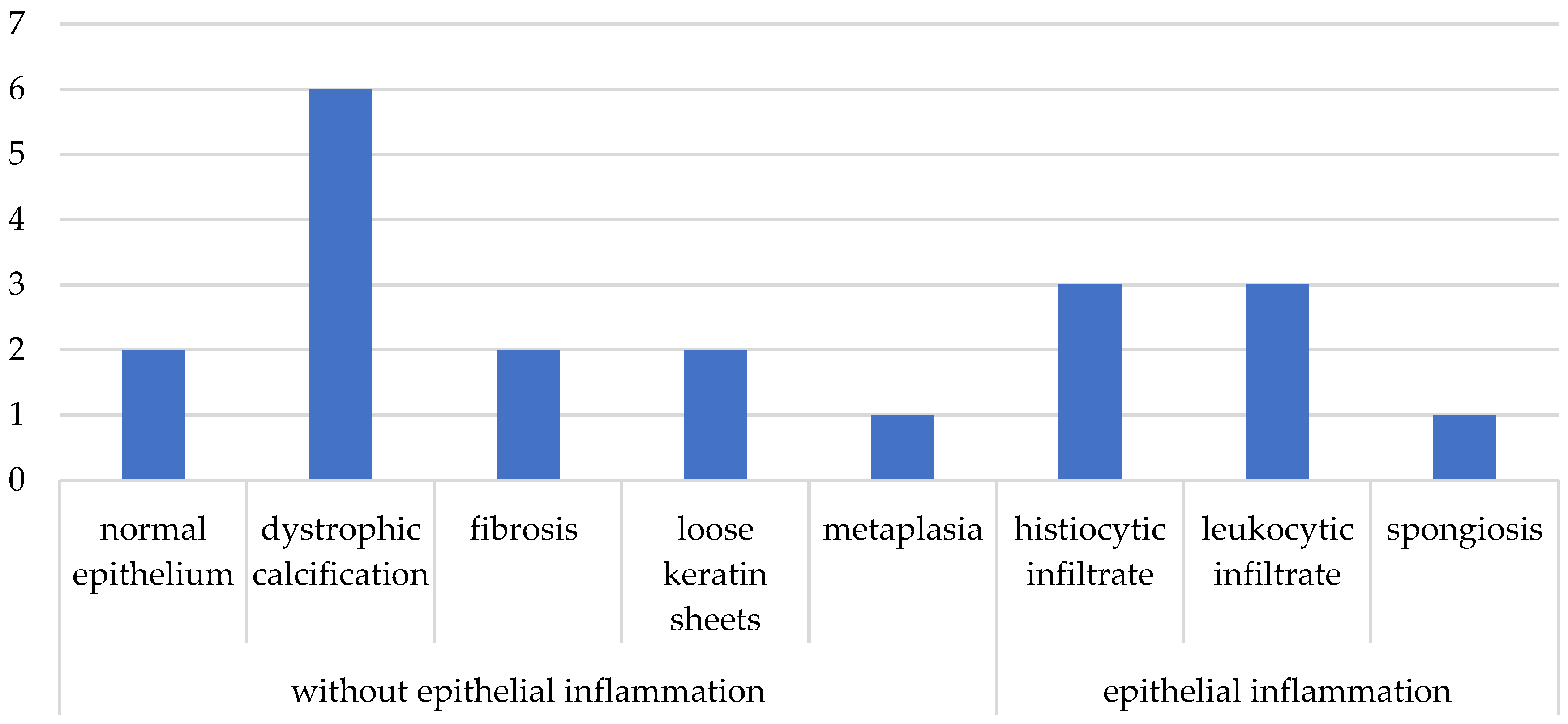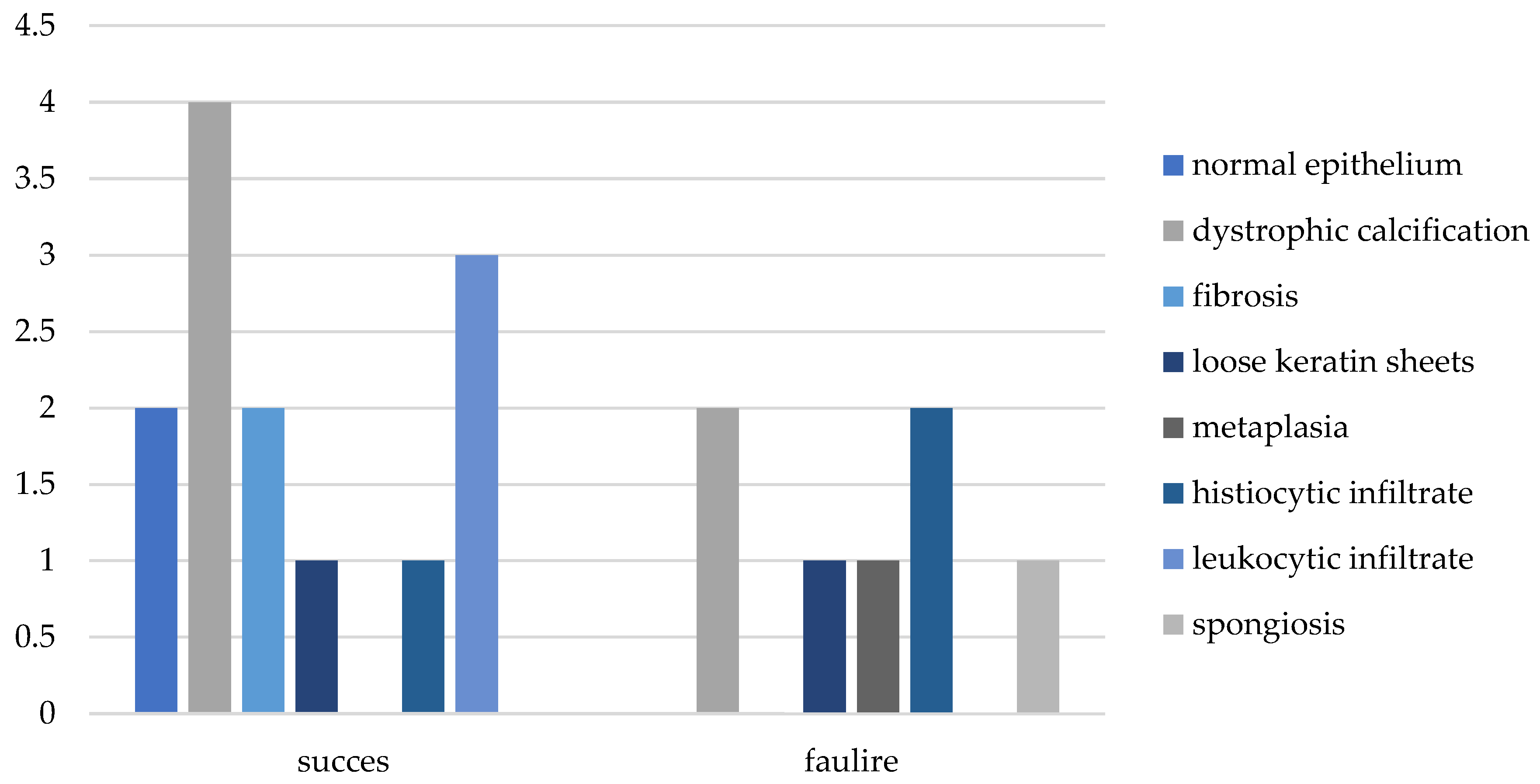The Impact of Epithelial Inflammation in Membrane Remnants on the Outcome of Tympanoplasty
Abstract
1. Introduction
2. Materials and Methods
3. Results
4. Discussion
5. Conclusions
Author Contributions
Funding
Institutional Review Board Statement
Informed Consent Statement
Data Availability Statement
Conflicts of Interest
References
- Campos, N.L.A.; Barron, S.M.B.; Fajardo, D.G.; México, D.F. Otitis media aguda y crónica, una enfermedad frecuente y evitable. Rev. Fac. Med. UNAM 2014, 57, 5–14. [Google Scholar]
- Schilder, A.G.; Chonmaitree, T.; Cripps, A.W.; Rosenfeld, R.M.; Casselbrant, M.L.; Haggard, M.P.; Venekamp, R.P. Otitis Media. Nat. Rev. Dis. Primers 2016, 2, 16063. Available online: www.nature.com/nrdp (accessed on 26 February 2023). [CrossRef] [PubMed]
- Fukuchi, I.; Cerchiari, D.P.; Garcia, E.; Rezende, C.E.B.; Rapoport, P.B. Tympanoplasty: Surgical results and a comparison of the factors that may interfere in their success. Braz. J. Otorhinolaryngol. 2006, 72, 267–271. [Google Scholar] [CrossRef] [PubMed]
- Marchisio, P.; Esposito, S.; Picca, M.; Baggi, E.; Terranova, L.; Orenti, A.; Biganzoli, E.; Principi, N.; Gallia, P.; Mazzucchi, E.; et al. Prospective evaluation of the aetiology of acute otitis media with spontaneous tympanic membrane perforation. Clin. Microbiol. Infect. 2017, 23, 486.e1–486.e6. [Google Scholar] [CrossRef]
- World Health Organization. Chronic Suppurative Otitis Media: Burden of Illness and Management Options; WHO: Geneva, Switzerland, 2004. Available online: https://iris.who.int/handle/10665/42941?search-result=true&query=tympanic+perforation&scope=&rpp=10&sort_by=score&order=desc (accessed on 20 October 2023).
- Mili, M.K.; Hoque, S.R.; Sarmah, M.; Phookan, J. Results of tympanoplasty in reference to the condition of middle ear mucosa and edge of perforation in safe chronic otitis media. Int. J. Otorhinolaryngol. Head Neck Surg. 2022, 8, 124–128. [Google Scholar] [CrossRef]
- Sharma, K.; Manjari, M.; Salaria, N. Middle Ear Cleft in Chronic Otitis Media: A Clinicohistopathological Study. Indian J. Otolaryngol. Head Neck Surg. 2013, 65, 493–497. [Google Scholar] [CrossRef]
- Coronado Terrazas, J. Eficacia del Cierre de Perforación con Injerto de Pericondrio en Pacientes sometidos a Timpanoplastia; Universidad Nacional Autónoma de México Coordinación General de Estudios de Posgrado, U.N.A.M.: Mexico City, Mexico, 2019. [Google Scholar]
- Luers, J.C.; Hüttenbrink, K.B. Surgical anatomy and pathology of the middle ear. J. Anat. 2016, 228, 338–353. [Google Scholar] [CrossRef]
- Ma, Y.; Zhao, H.; Zhou, X. Topical treatment with growth factors for tympanic membrane perforations: Progress towards clinical application. Acta Otolaryngol. 2002, 122, 586–599. [Google Scholar] [CrossRef]
- Gladstone, H.B.; Jackler, R.K.; Varav, K. Tympanic membrane wound healing. An overview. Otolaryngol. Clin. N. Am. 1995, 28, 913–932. [Google Scholar] [CrossRef]
- Sainsbury, E.; Amaral Rdo Blayney, A.W.; Walsh, R.M.C.; O’Brien, F.J.; O’Leary, C. Tissue engineering and regenerative medicine strategies for the repair of tympanic membrane perforations. Biomater. Biosyst. 2022, 6, 100046e1–10046e10. [Google Scholar] [CrossRef]
- Baudouin, R.; Denoyelle, F.; Simon, F. Shedding light on the tympanic membrane: A brief history of the description and understanding of its anatomy. J. Laryngol. Otol. 2022, 136, 97–102. [Google Scholar] [CrossRef] [PubMed]
- Johnson, A.; Hawke, M. The function of migratory epidermis in the healing of tympanic membrane perforations in guinea-pig. A photographic study. Acta Otolaryngol. 1987, 103, 81–86. [Google Scholar] [CrossRef] [PubMed]
- Reijnen, C.J.; Kuijpers, W. The healing pattern of the drum membrane. Acta Otolaryngol. Suppl. 1971, 287, 1–74. [Google Scholar] [PubMed]
- Wang, A.Y.; Shen, Y.; Wang, J.T.; Friedland, P.L.; Atlas, M.D.; Dilley, R.J. Animal models of chronic tympanic membrane perforation: A ‘time-out’ to review evidence and standardize design. Int. J. Pediatr. Otorhinolaryngol. 2014, 78, 2048–2055. [Google Scholar] [CrossRef]
- Mokoyan, Z.; Svistushkin, V.; Zolotova, A.; Svistushkin, M. Chronic tympanic membrane perforation: Histopathological evidence of the experimental model. Int. J. Pediatr. Otorhinolaryngol. 2021, 151, 110964. [Google Scholar] [CrossRef]
- Sadé, J.; Eliezer, N. Secretory otitis media and the nature of the mucociliary system. Acta Otolaryngol. 1970, 70, 351–357. [Google Scholar] [CrossRef]
- Cohen, J. Statistical Power Analysis for the Behavioral Sciences, 2nd ed.; Lawrence Erlbaum: Mahwah, NJ, USA, 1988. [Google Scholar]
- Bhadesia, B.; Joshi, H.; Desai, N.; Hirani, N.; Khilnani, A.K.; Sorathiya, R. A study of factors affecting the success rate of type-1 tympanoplasty. Int. J. Otorhinolaryngol. Head Neck Surg. 2020, 6, 2237–2242. [Google Scholar] [CrossRef]
- Jung, D.J.; Lee, H.J.; Hong, J.S.; Kim, D.G.; Mun, J.Y.; Bae, J.W.; Yoo, M.H.; Lee, K.Y. Prediction of hearing outcomes in chronic otitis media patients underwent tympanoplasty using ossiculoplasty outcome parameter staging or middle ear risk indices. PLoS ONE 2021, 16, e0252812. [Google Scholar] [CrossRef]
- Dash, M.; Deshmukh, P.; Gaurkar, S.S.; Sandbhor, A. A Review of the Middle Ear Risk Index as a Prognostic Tool for Outcome in Middle Ear Surgery. Cureus 2022, 14, e31038. [Google Scholar] [CrossRef] [PubMed] [PubMed Central]
- Asfaha, F.G.; Tesfa, B.B.; Gebremariam, L.W.; Geremew, A.; Temam, S.; Abreha, G.F. Tympanoplasty in Northern Ethiopia: Success rates, failure factors, and audiometric improvements. BMC Res. Notes 2025, 18, 52. [Google Scholar] [CrossRef]
- Valiya, V.; Kumar, R.; Kapadia, P.B.; Panchal, A.J.; Luhana, M.A.; Tailor, U. Association of Pre-operative Eustachian Tube Function with the Graft Uptake After Tympanoplasty. Indian J. Otolaryngol. Head Neck Surg. 2024, 76, 540–544. [Google Scholar] [CrossRef] [PubMed] [PubMed Central]
- Singh, A.; Talda, D.; Bhutia, C.D.; Aggarwal, S.K.; Chakraborty, P.; Kumari, S.; Yadav, S. A Prospective Randomised Comparative Study Between Cartilage and Fascia Tympanoplasty in a Tertiary Care Hospital to Look for Better Alternative in High Risk Cases. Indian J. Otolaryngol. Head Neck Surg. 2023, 75 (Suppl. S1), 50–59. [Google Scholar] [CrossRef] [PubMed] [PubMed Central]
- Mucha, S.; Bugnait, G.; Suri, G.S.; Vibhuti, V.; Prakash, S.; Akash, A.; Tiwari, V. Comparative Study on Temporalis Fascia Graft Versus Tragal Cartilage in Type-1 Tympanoplasty in Paediatric Patients. Indian J. Otolaryngol. Head Neck Surg. 2023, 75 (Suppl. S1), 396–402. [Google Scholar] [CrossRef] [PubMed] [PubMed Central]
- Chen, C.K.; Hsu, H.C.; Wang, M. Endoscopic tympanoplasty with post-conchal perichondrium in repairing large-sized eardrum perforations. Eur. Arch. Oto-Rhino-Laryngol. 2022, 279, 5667–5674. [Google Scholar] [CrossRef]
- Momin, Z.K.; Yancey, K.L.; Mitton, T.J.; Kutz, J.W. Patient Factors Predicting Success in Lateral Graft Tympanoplasty. Otol. Neurotol. Open 2022, 2, e015. [Google Scholar] [CrossRef]
- Moneir, W.; El-Kholy, N.A.; Ali, A.I.; Abdeltawwab, M.M.; El-Sharkawy, A.A.R. Correlation of Eustachian tube function with the results of type 1 tympanoplasty: A prospective study. Eur. Arch. Oto-Rhino-Laryngol. 2023, 280, 1593–1601. [Google Scholar] [CrossRef]
- Abdelhameed, W.; Rezk, I.; Awad, A. Impacto do tamanho do enxerto de cartilagem no sucesso da timpanoplastia. Braz. J. Otorhinolaryngol. 2017, 83, 507–511. [Google Scholar] [CrossRef]
- Hannoodee, S.; Nasuruddin, D.N. Acute Inflammatory Response. In StatPearls; StatPearls Publishing: Treasure Island, FL, USA, 2024. Available online: https://pubmed.ncbi.nlm.nih.gov/32310543/ (accessed on 29 April 2025).
- Eming, S.A.; Martin, P.; Tomic-Canic, M. Wound repair and regeneration: Mechanisms, signaling, and translation. Sci. Transl. Med. 2014, 6, 265sr6. [Google Scholar] [CrossRef]
- Wynn, T.A.; Vannella, K.M. Macrophages in Tissue Repair, Regeneration, and Fibrosis. Immunity 2016, 44, 450–462. [Google Scholar] [CrossRef]
- Leffers, D.; Penxova, Z.; Kempin, T.; Därr, M.; Fleckner, J.; Hollfelder, D.; Ryan, A.F.; Bruchhage, K.L.; Kurabi, A.; Leichtle, A. Immunomodulatory Response of the Middle Ear Epithelial Cells in Otitis Media. Otol. Neurotol. 2024, 45, E248–E255. [Google Scholar] [CrossRef]
- Han, Y.; Yang, R.; Mao, X.; Li, R.; Song, Y.; Shi, H.; Feng, Y.; An, X.; Zha, D.; Chen, Y. Comparison of the Impacts of Different Middle Ear Mucosal Conditions on Type I Tympanoplasty Outcomes. J. Otolaryngol. Head Neck Surg. 2024, 53, 19160216241267724. [Google Scholar] [CrossRef]



| Variable | n = 20 |
|---|---|
| Sex, women, N (%) | 15 (75) |
| Age, years, mean, (SD) | 56.7 (10.9) |
| ATA, dB, mean (SD) | 45.5 (15) |
| OOPS index, mean (SD) | 2.45 (1.5) |
| Tubal dysfunction, present, N (%) | 16 (80) |
| Ear, right, N (%) | 10 (50) |
| Perforation site, central, N (%) | 12 (60) |
| Perforation size | |
| <30% N (%) | 3 (15) |
| 30–60% N (%) | 13 (65) |
| >60% N(%) | 4 (20) |
| Mastoids, well pneumatized, N (%) | 10 (50) |
| Variable | Epithelial Inflammation | ||
|---|---|---|---|
| Present | Absent | ||
| n = 12 | n = 8 | p | |
| Sex, women, N (%) | 10 (83.33) | 5 (62.5) | 0.296 ` |
| Age, years, mean, (SD) | 52 (13.3) | 52.6 (14.6) | 0.427 ** |
| ATA, dB, mean (SD) | 50.8 (15.8) | 42.4 (12.9) | 0.313 ** |
| OOPS index, mean (SD) | 3.13 (1.12) | 2(1.7) | 0.145 ** |
| Tubal dysfunction, present, N (%) | 10 (83.33) | 6 (75) | 0.535 ` |
| Ear, right, N (%) | 7 (58.33) | 3 (37.5) | 0.325 ` |
| Perforation site, central, N (%) | 7 (58.33) | 5 (62.5) | 0.612 ` |
| Perforation size | |||
| <30% N (%) | 2 (16.66) | 1 (12.5) | 0.651 ° |
| 30–60% N (%) | 8 (66.66) | 5 (62.5) | |
| >60% N (%) | 2 (16.66) | 2 (25) | |
| Mastoids, well pneumatized, N (%) | 5 (41.66) | 5 (62.5) | 0.325 ` |
| Beta | Standard Error | Odds Ratio | CI 95% Lower | CI 95% Upper | |
|---|---|---|---|---|---|
| Central perforation | −1979 | 1564 | 0.138 | 0.006 | 2962 |
| 30–60% perforation | 0.966 | 1435 | 2627 | 0.158 | 43,759 |
| Sclerotic mastoid | 0.912 | 1405 | 2489 | 0.158 | 39,092 |
| Presence of inflammation | 1244 | 1133 | 3469 | 0.377 | 31,940 |
| Beta | Standard Error | Odds Ratio | CI 95% Lower | CI 95% Upper | |
|---|---|---|---|---|---|
| OOPS index | 1249 | 0.857 | 3489 | 0.650 | 18,712 |
| Tubal dysfunction present | −3353 | 2638 | 0.035 | 0.000 | 6163 |
| Sclerotic mastoid | −4044 | 2545 | 0.018 | 0.000 | 2569 |
| Left ear affected | −2130 | 1558 | 0.119 | 0.006 | 2518 |
| Marginal perforation | 1994 | 2002 | 7342 | 0.145 | 371,586 |
| Perforation 30–60% | −7506 | 4873 | 0.001 | 0.000 | 7731 |
| Perforation >60% | −3854 | 2867 | 0.021 | 0.000 | 5850 |
| Inadequate ear care | −4025 | 3017 | 0.018 | 0.000 | 6606 |
Disclaimer/Publisher’s Note: The statements, opinions and data contained in all publications are solely those of the individual author(s) and contributor(s) and not of MDPI and/or the editor(s). MDPI and/or the editor(s) disclaim responsibility for any injury to people or property resulting from any ideas, methods, instructions or products referred to in the content. |
© 2025 by the authors. Licensee MDPI, Basel, Switzerland. This article is an open access article distributed under the terms and conditions of the Creative Commons Attribution (CC BY) license (https://creativecommons.org/licenses/by/4.0/).
Share and Cite
Galindo-Tapia, M.F.; Deras-Quiñones, A.E.; Montoya-Fuentes, I.M.; Madrigal-Santillán, E.O.; Morales-González, Á.; Flores-Fuentes, N.A.; Anguiano-Robledo, L.; Rojas-Martínez, R.; Montaño-Velázquez, B.; Morales-González, J.A. The Impact of Epithelial Inflammation in Membrane Remnants on the Outcome of Tympanoplasty. Med. Sci. 2025, 13, 73. https://doi.org/10.3390/medsci13020073
Galindo-Tapia MF, Deras-Quiñones AE, Montoya-Fuentes IM, Madrigal-Santillán EO, Morales-González Á, Flores-Fuentes NA, Anguiano-Robledo L, Rojas-Martínez R, Montaño-Velázquez B, Morales-González JA. The Impact of Epithelial Inflammation in Membrane Remnants on the Outcome of Tympanoplasty. Medical Sciences. 2025; 13(2):73. https://doi.org/10.3390/medsci13020073
Chicago/Turabian StyleGalindo-Tapia, María Fernanda, Alejandro Esteban Deras-Quiñones, Itzel Maria Montoya-Fuentes, Eduardo Osiris Madrigal-Santillán, Ángel Morales-González, Naria A. Flores-Fuentes, Liliana Anguiano-Robledo, Raúl Rojas-Martínez, Beatriz Montaño-Velázquez, and José A. Morales-González. 2025. "The Impact of Epithelial Inflammation in Membrane Remnants on the Outcome of Tympanoplasty" Medical Sciences 13, no. 2: 73. https://doi.org/10.3390/medsci13020073
APA StyleGalindo-Tapia, M. F., Deras-Quiñones, A. E., Montoya-Fuentes, I. M., Madrigal-Santillán, E. O., Morales-González, Á., Flores-Fuentes, N. A., Anguiano-Robledo, L., Rojas-Martínez, R., Montaño-Velázquez, B., & Morales-González, J. A. (2025). The Impact of Epithelial Inflammation in Membrane Remnants on the Outcome of Tympanoplasty. Medical Sciences, 13(2), 73. https://doi.org/10.3390/medsci13020073






